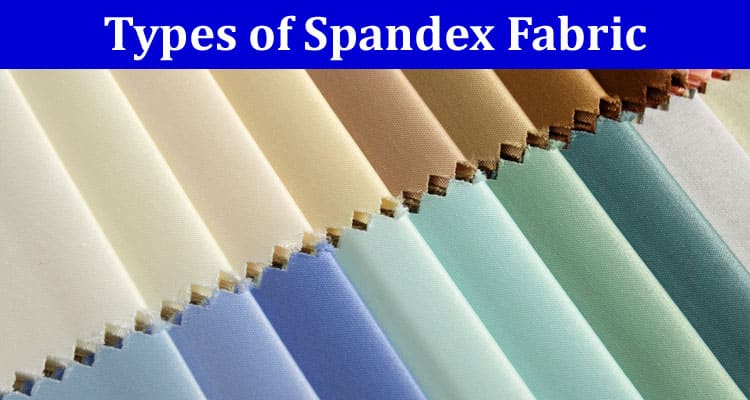Spandex fabrics are popular for form-fitting clothes, including tights, joggers, slim-fit denim and bras. The material is also used in socks and athletic/exercise wear.
Spandex fibers can be stretched many times over without losing their elasticity. They are also resistant to heat, light atmospheric contaminants, chlorine and many other chemicals.
It is a Synthetic Fiber.
Spandex is a type of synthetic fiber known for its mind-blowing stretchability. It is produced from a polyurethane polymer with a unique chemical structure that gives it elasticity. The polymer comprises a series of strands with rigid segments and amorphous sections. The undeveloped portions have a random molecular structure and intermingle with each other to make the fiber soft. When a force is applied to the spandex, the rigid segments break apart, and the amorphous sections stretch. When the power is removed, the undeveloped portions recoil and the fibers return to their original state.
There are various types of spandex fabric. Spandex can also be used with other types of fibers to produce a fabric with the properties of both fibers. For example, it can be used to make elastic core-spun yarn. This yarn can make tights, shapewear, and athletic apparel. In addition, it can be used in medical products like braces.
The production process for elastane is complex and requires several steps. Manufacturers first react monomers to create a prepolymer. Then, they mix the prepolymer with diamine acid and other ingredients to produce a spinning solution. This solution is pumped into a cylindrical spinning cell containing a spinneret. The spinning solution is then cured and converted into fibers. The resulting fibers are cut into various lengths and bundled to form the necessary thickness.
It is Manufactured
Spandex is a stretchable textile that has a wide range of applications. It is used in clothing and sports textiles, including swimwear and bicycling apparel. It can also be added to cotton and polyester fabrics to increase their elasticity. This allows the material to stretch up to eight times its original length. It is also used in movie motion capture suits to produce realistic 3-D characters.
To make spandex, two types of prepolymers are reacted to produce the fiber polymer backbone. The first is a flexible macro glycol, which can be polyester, polyether, polycarbonate, or polycaprolactone. This molecule has hydroxyl groups on both ends and is the key to the stretching characteristics of the spandex fiber. The other prepolymer is a stiff diisocyanate, which has an isocyanate group on both ends and provides rigidity.
During the manufacturing process, various tests are performed to evaluate the quality of the spandex fibers. These tests include elongation, resilience, and odor. These tests are required to ensure that the quality of the product is consistent from batch to batch.
Stabilizers are added to the polyurethane to reduce the risk of damage to the fibers. These additives help prevent degradation caused by heat, light, and atmospheric contaminants. They can also prevent the growth of mildew and other microorganisms that can affect the durability of the fibers.
It is used in Clothing.
Spandex fabric is an artificial fiber used in any garment that needs elasticity. It was first developed in World War II by chemists seeking a synthetic replacement for rubber. Its inception was prompted by two factors: First, the war effort consumed most of the available rubber, and second, the price of rubber fluctuated rapidly. Currently, spandex is used in hosiery, swimsuits, and sportswear. It can also be woven into other fabrics to add stretch and comfort.
It is made from polyurethane, a large molecule of repeating subunits called monomers. The monomers are reacted in a laboratory setting to form a polymer chain, resulting in a stretchy and resilient fabric with many uses. It is also sweat-resistant, making it ideal for athletic or active wear. The material also does not lint, and special coatings prevent the development of unpleasant odors.
The elastomeric fiber of spandex is composed of low-melting, amorphous “soft” segments and high-melting, crystalline “hard” segments. These segments have minimal interaction force and are clung together by strong hydrogen bonding. This combination allows the soft part to be stretched over 200% of its original length and then easily retract back into place without tearing. The fiber has an elastic recovery rate of typically 95% or higher, much faster than latex.
It is a Health Hazard.
Spandex fabrics are made from synthetic fibers and contain chemicals like polyurethane. When long-term exposure occurs, these chemicals can cause various health problems. These include breathing issues, skin irritation, and even cancer. In addition, these fibers don’t absorb sweat, which means that your body may become a fertile ground for various bacterial infections. Some of these infections include ringworm, impetigo, and folliculitis. Additionally, long-term spandex wear can lead to a buildup of difficult odors to eliminate.
Spandex can be found in various clothing but is most commonly used in stretchy athletic apparel and tights. It also has good abrasion resistance and is resistant to most acids and detergents. It is often combined with other materials, such as cotton and wool, to create different products.
Developed during World War II, spandex was an excellent alternative to rubber, which was in short supply then. The primary motivation for developing this synthetic material was to improve the durability of military equipment. Its development was accelerated by the need for more durable equipment and the unstable price of natural rubber.


